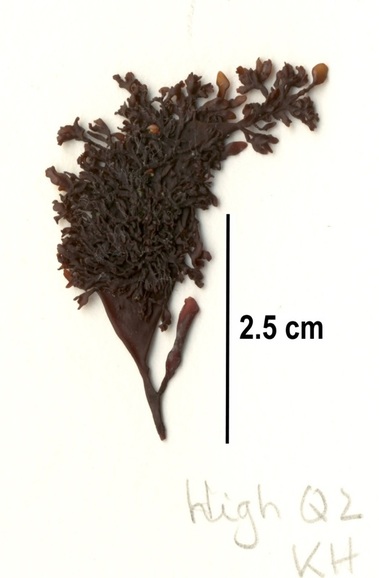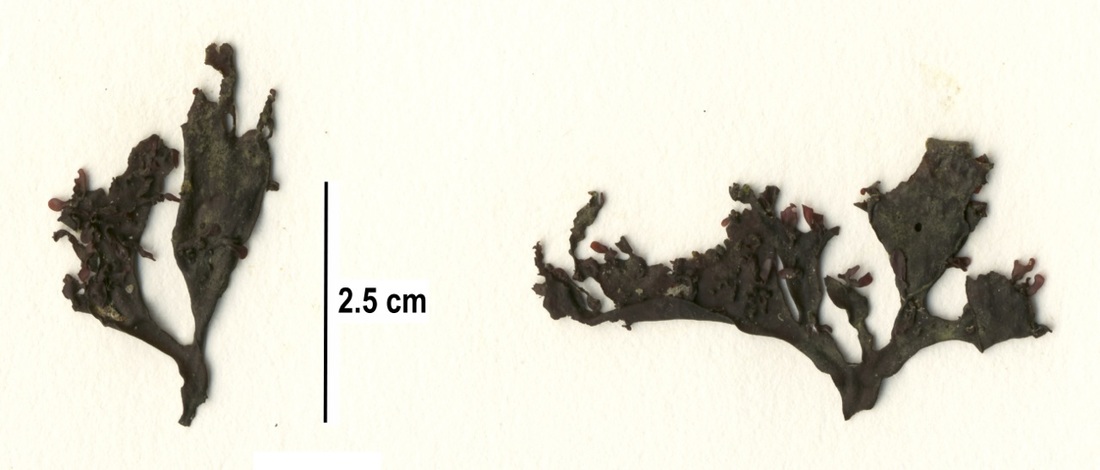Mastocarpus intermedius
|
Specimens found on a Calvert Island beach; collection numbers SCL 15272 (left) and SCL 15275 (right) in the UBC Herbarium Alage Database. Photos courtesy of Sandra Lindstrom. More details about these specimens and about other occurrences of this species can be found by searching the collection numbers or species name in the database.
|
Identification
Turkish washcloth (Mastocarpus papillatus) was recently split into six separate species, one of which is M. intermedius. The gametophyte of this red alga is reddish-black and grows upright to 9 cm tall with a short (less than 1 cm) unbranched stipe leading into a 1-2 cm long apophysis (swelling). The blades are around 20 cm thick with rounded or irregular tips and may or may not be branched. Papillae cover both sides as well as margins of male and female gametophytes; these papillae differ in shape and density between male and female.
Details on morphological characteristics and molecular identification can be found in Lindstrom et al. (2011).
Habitat & Range
This species grows on rock, and has been mainly found in the mid- to low intertidal. It has been reported on Kodiak Island, Alaska and from northern British Columbia to Ensenada, Baja California.
Similar Species
Other Mastocarpus species can appear very similar, and while morphological characteristics, distribution, and location in the intertidal can lead to a field identification, genetic analysis is necessary to be certain of a correct identification. Other species of the genus reported on the BC coast are M. agardhii, M. vancouveriensis, M. papillatus, M. alaskensis, M. latissimus, and M. rigidus. See Lindstrom et al. (2011) for information on these similar species.
Turkish washcloth (Mastocarpus papillatus) was recently split into six separate species, one of which is M. intermedius. The gametophyte of this red alga is reddish-black and grows upright to 9 cm tall with a short (less than 1 cm) unbranched stipe leading into a 1-2 cm long apophysis (swelling). The blades are around 20 cm thick with rounded or irregular tips and may or may not be branched. Papillae cover both sides as well as margins of male and female gametophytes; these papillae differ in shape and density between male and female.
Details on morphological characteristics and molecular identification can be found in Lindstrom et al. (2011).
Habitat & Range
This species grows on rock, and has been mainly found in the mid- to low intertidal. It has been reported on Kodiak Island, Alaska and from northern British Columbia to Ensenada, Baja California.
Similar Species
Other Mastocarpus species can appear very similar, and while morphological characteristics, distribution, and location in the intertidal can lead to a field identification, genetic analysis is necessary to be certain of a correct identification. Other species of the genus reported on the BC coast are M. agardhii, M. vancouveriensis, M. papillatus, M. alaskensis, M. latissimus, and M. rigidus. See Lindstrom et al. (2011) for information on these similar species.
References
Lindstrom, S. C., Hughey, J. R., and Martone, P. T. (2011). New, resurrected and redefined species of Mastocarpus (Phyllophoraceae, Rhodophyta) from the northeast Pacific. Phycologia. 50(6): 661–683.
Authors and editors of page
Kelly Fretwell and Brian Starzomski (2015).
Lindstrom, S. C., Hughey, J. R., and Martone, P. T. (2011). New, resurrected and redefined species of Mastocarpus (Phyllophoraceae, Rhodophyta) from the northeast Pacific. Phycologia. 50(6): 661–683.
Authors and editors of page
Kelly Fretwell and Brian Starzomski (2015).






